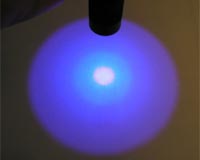 |
Oak Ridge TN (SPX) Apr 27, 2011 Novel properties of ferroelectric materials discovered at the Department of Energy's Oak Ridge National Laboratory are moving scientists one step closer to realizing a new paradigm of electronic memory storage. A new study led by ORNL's Peter Maksymovych and published in the American Chemical Society's Nano Letters revealed that contrary to previous assumptions, domain walls in ferroelectric materials act as dynamic conductors instead of static ones. Domain walls, the separation zones only a few atoms wide between opposing states of polarization in ferroelectric materials, are known to be conducting, but the origin of the conductivity has remained unclear. "Our measurements identified that subtle and microscopically reversible distortions or kinks in the domain wall are at the heart of the dynamic conductivity," Maksymovych said. "The domain wall in its equilibrium state is not a true conductor like a rigid piece of copper wire. When you start to distort it by applying an electric field, it becomes a much better conductor." Ferroelectrics, a unique class of materials that respond to the application of an electric field by microscopically switching their polarization, are already used in applications including sonar, medical imaging, fuel injectors and many types of sensors. Now, researchers want to push the boundaries of ferroelectrics by making use of the materials' properties in areas such as memory storage and nanoelectronics. Gaining a detailed understanding of electrical conductance in domain walls is seen as a crucial step toward these next generation applications. "This study shows for the first time that the dynamics of these defects - the domain walls - are a much richer source of memory functionality," Maksymovych said. "It turns out you can dial in the level of the conductivity in the domain wall, making it a tunable, metastable, dynamic memory element." The domain wall's tunable nature refers to its delayed response to changes in conductivity, where shutting off an electric field does not produce an immediate drop in conductance. Instead, the domain wall "remembers" the last level of conductance for a given period of time and then relaxes to its original state, a phenomenon known as memristance. This type of behavior is unlike traditional electronics, which rely on silicon transistors that act as on-off switches when electric fields are applied. "Finding functionality intrinsic to nanoscale systems that can be controlled in a novel way is not a path to compete with silicon, but it suggests a viable alternative to silicon for a new paradigm in electronics," Maksymovych said. The ORNL-led team focused on bismuth ferrite samples, but researchers expect that the observed properties of domain walls will hold true for similar materials. "The resulting memristive-like behavior is likely to be general to ferroelectric domain walls in semiconducting ferroelectric and multiferroic materials," said ORNL co-author Sergei Kalinin. The samples used in the study were provided by the University of California at Berkeley. Other authors are ORNL's Arthur Baddorf, Jan Seidel and Ramamoorthy Ramesh of Lawrence Berkeley National Laboratory and UC Berkeley, and Pennsylvania State University's Pingping Wu and Long-Qing Chen.
Share This Article With Planet Earth
Related Links Center for Nanophase Materials Sciences at ORNL Computer Chip Architecture, Technology and Manufacture Nano Technology News From SpaceMart.com
 LED efficiency puzzle solved
LED efficiency puzzle solvedSanta Barbara CA (SPX) Apr 25, 2011 Researchers at the University of California, Santa Barbara, say they've figured out the cause of a problem that's made light-emitting diodes (LEDs) impractical for general lighting purposes. Their work will help engineers develop a new generation of high-performance, energy-efficient lighting that could replace incandescent and fluorescent bulbs. "Identifying the root cause of the problem ... read more |
|
| The content herein, unless otherwise known to be public domain, are Copyright 1995-2010 - SpaceDaily. AFP and UPI Wire Stories are copyright Agence France-Presse and United Press International. ESA Portal Reports are copyright European Space Agency. All NASA sourced material is public domain. Additional copyrights may apply in whole or part to other bona fide parties. Advertising does not imply endorsement,agreement or approval of any opinions, statements or information provided by SpaceDaily on any Web page published or hosted by SpaceDaily. Privacy Statement |